With a more upscale grand piano sound and even more compact dimensions than its predecessor, the Yamaha P-225 should score points not only within its series.
Pros and Cons
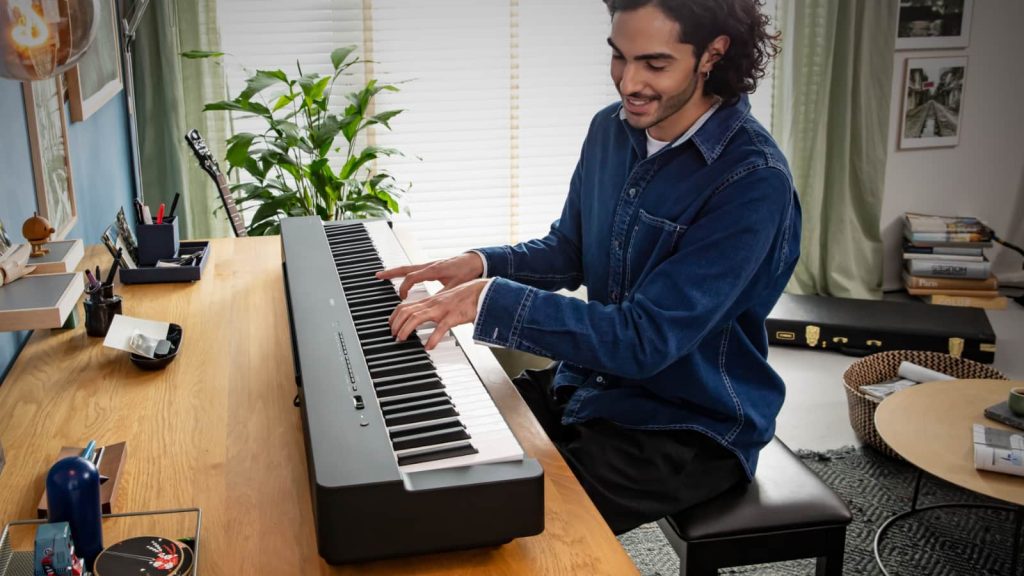
With a more upscale grand piano sound and even more compact dimensions than its predecessor, the Yamaha P-225 should score points not only within its series.
Within Yamaha’s Portable Series, the P models with a “200” in their name were heavy, 30-pound behemoths. However, the P-225, which comes after the P-125, is slightly less bulky than its predecessor. This was made possible by replacing the “Graded Hammer Standard” (GHS) keyboard with the “GHC” (“C” as in “Compact”).
Compared to the P-125, the P-225 has a new case and four built-in speakers in new positions. Yamaha also redesigned the control panel, which still lacks a display, though no new buttons were added. Though this instrument costs less than $1,000 and is built into a plastic chassis, the workmanship appears neat. Furthermore, the narrower base supports the rest of the piano body and conceals the two connection panels.
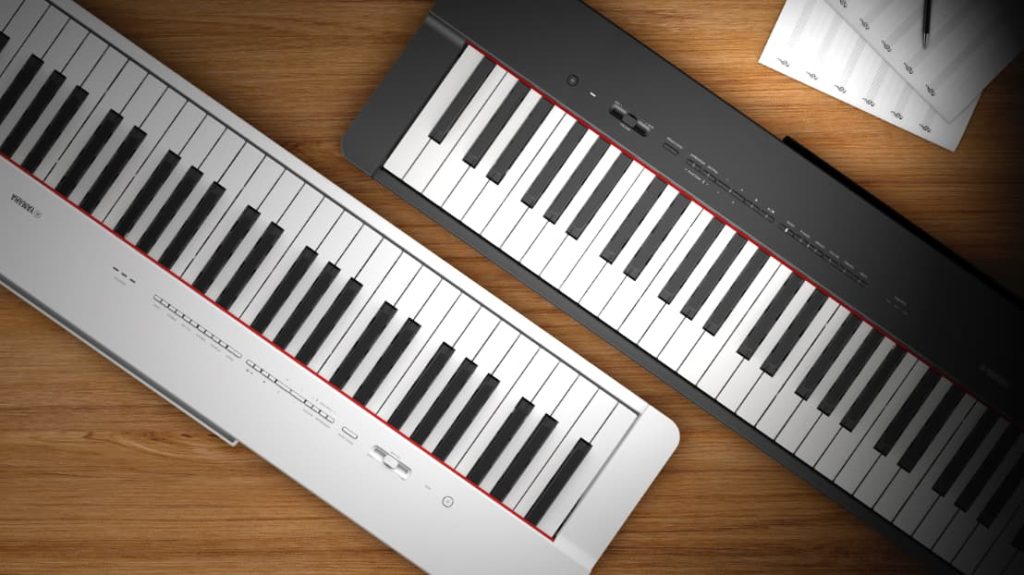
It’s less problematic with the two headphone jacks on the front left, but more so with the rear panel. You can only access the sustain and triple pedals, the USB-to-Host connection (including USB audio/MIDI), the stereo outputs for standard jacks, and the power supply socket from the back of the Yamaha P-225. However, this design has one advantage. The connected cables barely protrude above the top of the case and are thus well protected.
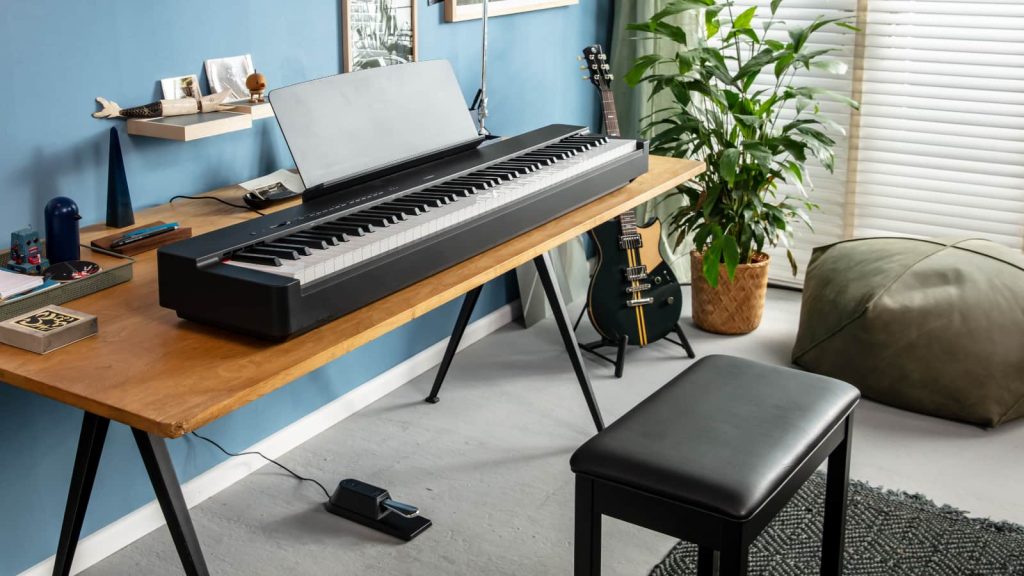
The portable piano comes with a music stand, foot switch, and external power supply. You can choose between white and black versions. A stand and a triple pedal unit are available for purchase, and permanent installation is possible. With these additions, the P-225 passes not only as a fashionable digital upright piano but also as an accessory that enhances playability.
The Yamaha P-225 has a simple foot switch that activates the sustain function. While you can play with it, it does not exactly recreate the feel of a piano. Unfortunately, the manufacturer cut costs here, so you should plan on purchasing an optional sustain pedal right away.

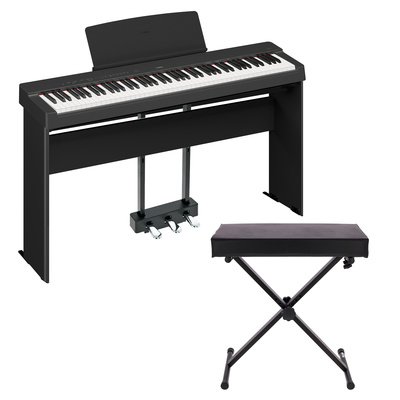
While the predecessor still uses the “Pure CF” sound generation, the P-225 is the first model under $1,000 to feature the CFX concert grand sound. This sound, which is also found in the expensive P models 515/525 and S500, comes from the in-house Clavinova series.
This upgrade establishes the mid-range P model as a top contender for the title of best-sounding portable piano in its class. Its excellent grand piano sound features realistic string, damper, and cabinet resonances (here, “VRM Lite,” which is not adjustable in detail). Also convincing in the length of the samples and the decay, it is available in three other variants: a live-oriented as well as a more muted sound, and a mid-emphasized bright piano.
The grand piano sounds coherent even through the built-in playback system alone. A notable feature in this price range is the four speakers, a feature inherited from the previous model. Despite its modest amplifier power, the sound from the P-225’s front and rear speakers is pleasantly transparent and present. The sound remains undisturbed even at full volume.
The new keyboard plays well with decent resistance and feels familiar. Like the GHS, it is one of the heavier weighted manuals. The GHS’s repetition is just as good, and you will quickly grow accustomed to it. While you have to do without textured top layers, at least the black keys have a matte finish for a better grip.
For piano lessons, there is also the duo function, which makes the grand piano sound playable on each half of the split keyboard. Accordingly, there is a second headphone jack.
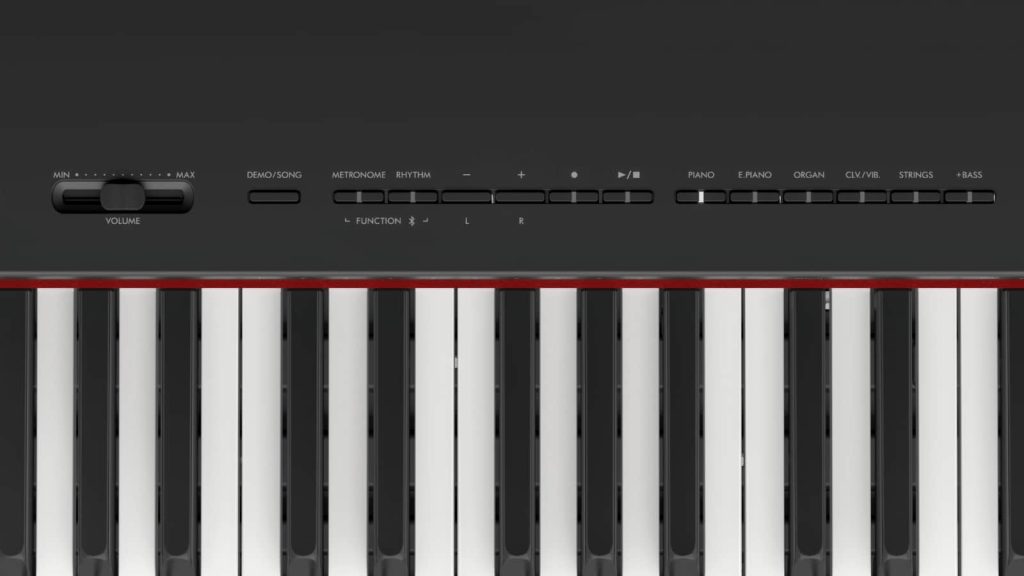
Similar to its predecessor, the P-225’s 24 sounds are organized into six groups, each containing four sounds. Each group contains one main sound and three “variations,” but these variations often consist of completely different sounds. Selecting sounds is straightforward, even without a display.
In addition to the four grand piano sounds in the “A. Piano” group, the “E. Piano” group features a Fender Rhodes, a DX7 piano, a Wurlitzer, and a synthetic electric piano with a surface component. The “Organ” section offers jazz and rock Hammond organ sounds, as well as a church organ with two registrations.
The “Clv./Vib.” section adds a funky clavinet and a vibraphone with tremolo to the selection, as well as a realistic harpsichord and its octave version. Realistic stereo strings in dynamic and slow variations, a nice choir sound, and a universal synthpad occupy the “Strings” group.
You can quickly layer many of these sounds by pressing two of the group buttons simultaneously. If desired, you select variations of the sounds beforehand. However, layering two sounds from the same group is not possible with this method. Thanks to 192-voice polyphony, you can play layered sounds with confidence.
The sixth sound group, “Bass,” contains a double bass with and without cymbals, a bass guitar, and a fretless bass. You can only play these four bass sounds in split mode. Here, a sound from another bank is always present on the right side of the keyboard.
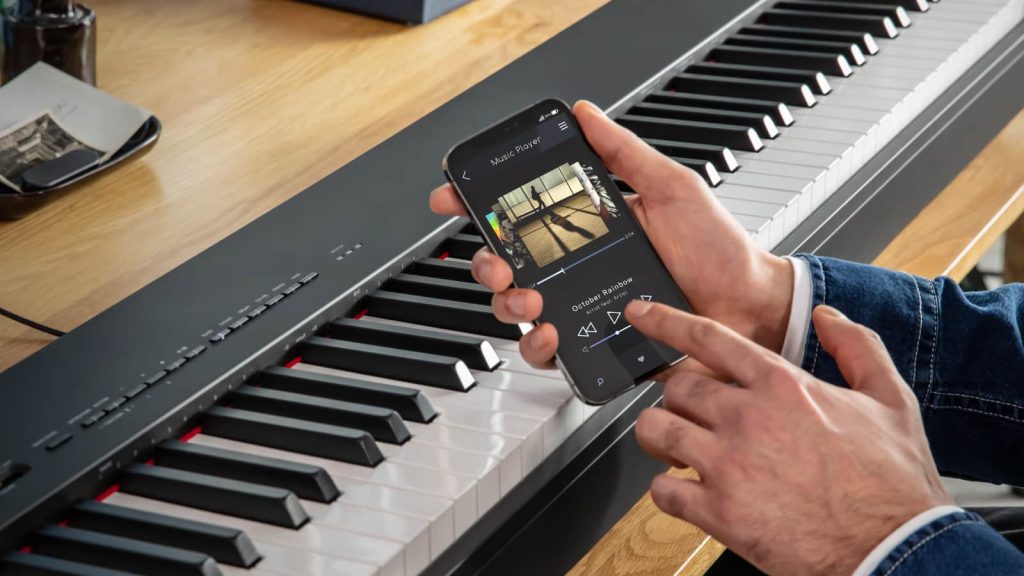
You can adjust the intensity of the four reverb effect types, which simulate rooms ranging from clubs to large concert halls. Additionally, certain sounds feature fixed and permanently assigned modulation effects, such as chorus and rotary speaker.
All of the additional sounds seem to be handpicked and of high quality. The same applies to the realistic drum set integrated for playing 20 rhythms. These drum grooves, ranging from rock and pop to Latin, feature an automatic bass track that follows the harmonies played with the left hand. It’s a motivating feature for jamming, though it could have come with more rhythms.
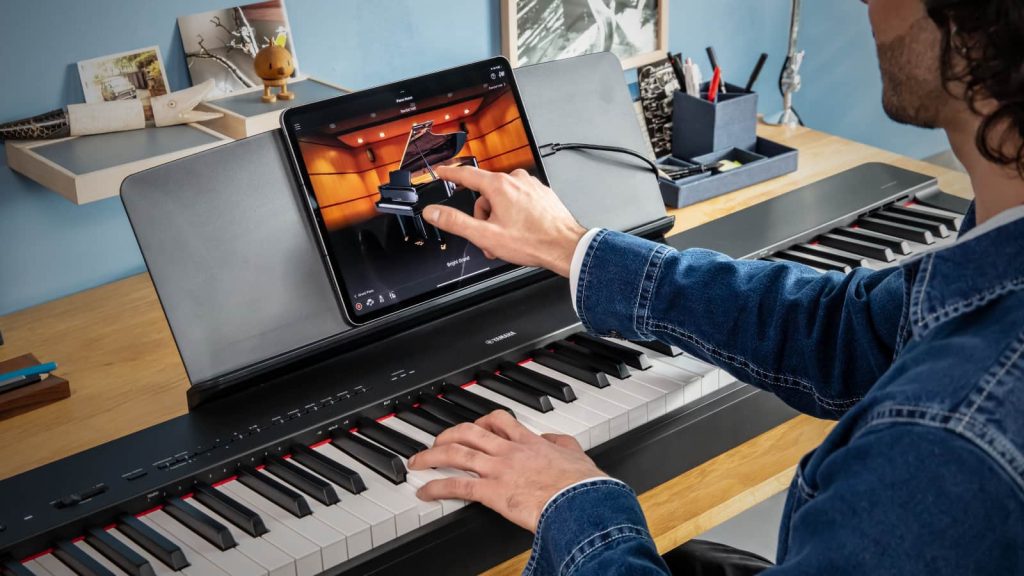
The P-225 comes equipped with a transposer and metronome. It also features a small, two-track recorder for MIDI song recording, which is particularly useful for recording the right and left-hand voices separately. However, it can only store one user song. Yamaha’s 50 “Classical Musical Masterpieces” are available again for ambidextrous rehearsing. You may already be familiar with them from the Arius digital upright pianos.
The P-225 is compatible with the free Yamaha “Smart Pianist” app. Unlike its predecessor, the piano can wirelessly connect to a mobile device with the app via the Bluetooth interface.
This software provides access to more than 300 additional MIDI practice tracks and features notation and a note-tracking display. With the app, you can record songs as MIDI or audio files. Then, using a tablet or smartphone, you can back up numerous recordings. Additionally, you can play a library of songs on an external player through the piano speakers.
As always, the app shines with its control functions. The touch display on mobile devices makes it super convenient to adjust settings on the Yamaha P-225. However, setting parameters on the piano itself, such as changing the metronome tempo or the volume and octave positions of the two-layer sounds, requires simultaneously pressing the keyboard keys and the function button.
Furthermore, the manufacturer recommends using the “Rec’n’Share” app to quickly create video clips of your performance and share them online. Originally popularized by Yamaha’s e-drums, the app’s functionality will reportedly expand to include keyboards. First, record the video using the camera on a smartphone or tablet. Then, you can easily edit the video and audio in the app to prepare your work for YouTube and other social networks.
As described above, you can easily accomplish audio and video recording using the Rec’n’Share app. The USB connection transmits both USB MIDI and digital audio signals, unlike its predecessor. This allows you to play online lessons or piano app sounds, such as those from Pure Piano, via the Yamaha P-225’s speaker system. While you do not need any audio cables apart from a USB cable, you will need a Camera Connection Kit for iOS devices or an OTG adapter for Android devices.
The more affordable P-145 is Yamaha’s second compact model with a GHC keyboard. Its primary sound is a multisample of a Yamaha CFIII grand piano, complete with damper resonance. This sound is slightly more subdued than the noble CFX sound, and it has a maximum polyphony of 64 voices. The P-225, on the other hand, has VR Lite technology, which allows it to reproduce string resonances in greater detail.
With two speakers, the built-in playback system is also simpler, and ten voices reduce the sound selection to the bare minimum. Unfortunately, the P-145 does not have separate outputs, so you have to use a headphone jack for external amplification. While Bluetooth is not supported, a USB cable connection is.
Compatibility with the Yamaha apps allows retrofitting of learning and recording functions. A stand with a triple pedal is also optionally available for this model. The P-145 is a budget alternative to the P-225, which is better equipped in many respects.
Among pianists, Yamaha’s affordable P series has always been a popular alternative to expensive stage pianos, allowing them to perform without breaking the bank. The Yamaha P-225 will continue this trend with its excellent Clavinova CFX grand piano sound as a noticeable upgrade.
You will quickly grow fond of the GHC keys and the other features of this compact, lightweight piano. From the sound selection to the app operation and the USB audio/MIDI function, everything leaves a well-rounded impression. One minor criticism: In this price range, the piano should come with a decent sustain pedal instead of a footswitch.
Pros and Cons
Compared to the predecessor, the CFX sound is a noticeable upgrade.
You are currently viewing a placeholder content from Facebook. To access the actual content, click the button below. Please note that doing so will share data with third-party providers.
More InformationYou are currently viewing a placeholder content from Instagram. To access the actual content, click the button below. Please note that doing so will share data with third-party providers.
More InformationYou are currently viewing a placeholder content from X. To access the actual content, click the button below. Please note that doing so will share data with third-party providers.
More Information